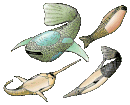| Astraspis Temporal range: middle-late Ordovician
| |
|---|---|

| |
| Fossil specimen of A. desiderata, Field Museum of Natural History | |
| Scientific classification | |
| Domain: | Eukaryota |
| Kingdom: | Animalia |
| Phylum: | Chordata |
| Infraphylum: | Agnatha |
| Class: | †Pteraspidomorphi |
| Subclass: | †Heterostraci |
| Order: | †Pteraspidiformes |
| Genus: | †Astraspis Walcott, 1892[1] |
| Type species | |
| Astraspis desiderata Walcott 1892
| |
| Species | |
| |
Astraspis ('star shield') is an extinct genus of primitive jawless fish from the Ordovician of Central North America including the Harding Sandstone of Colorado and Bighorn Mountains of Wyoming. It is also known from Bolivia.[2] It is related to other Ordovician fishes, such as the South American Sacabambaspis, and the Australian Arandaspis.
YouTube Encyclopedic
-
1/3Views:52 2231 768 80015 925
-
What if we had 2 Heads, Elephant-like & Human-like? + more videos | #aumsum #kids #children #whatif
-
15 Most Terrifying Creatures That Lived Before Dinosaurs
-
Эволюция тела человека от докембрия до наших дней | Станислав Дробышевский (Аудиокнига)
Transcription
Description

Nearly complete fossils suggest the living animals were about 200 mm (7.9 in) in length. The body had a mobile tail covered with small protective plate-like scales of less than 1 mm (0.039 in) and a forebody covered with plate-like scales larger than 2 mm (0.079 in). The specimen from North America (described by Sansom et al., 1997) is to have had relatively large, laterally-positioned eyes and a series of eight gill openings on each side. The specimen was generally oval in cross-section. The protective bony plates covering the animal were composed of aspidin (chemically similar to modern shark's teeth), covered by tubercles composed of dentine.[3] It is from these tubercles (which are generally star-shaped) that the name 'Astraspis' (literally "star-shield") is derived.
References
- ^ C. D. Walcott. 1892. Preliminary notes on the discovery of a vertebrate fauna in Silurian (Ordovician) strata. Geological Society of America Bulletin 3:153-172
- ^ Sacabambaspis janvieri. PY Gagnier - Vertébré ordovicien de Bolivie, 1993
- ^ Sansom IJ, Smith MP, Smith MM and Turner P (1997) "Astraspis: The anatomy and histology of an Ordovician fish" Palaeontology, 40 (3): 625–642.
Other sources
Michael J. Benton, Vertebrate Palaeontology, 3rd edition, 2005






